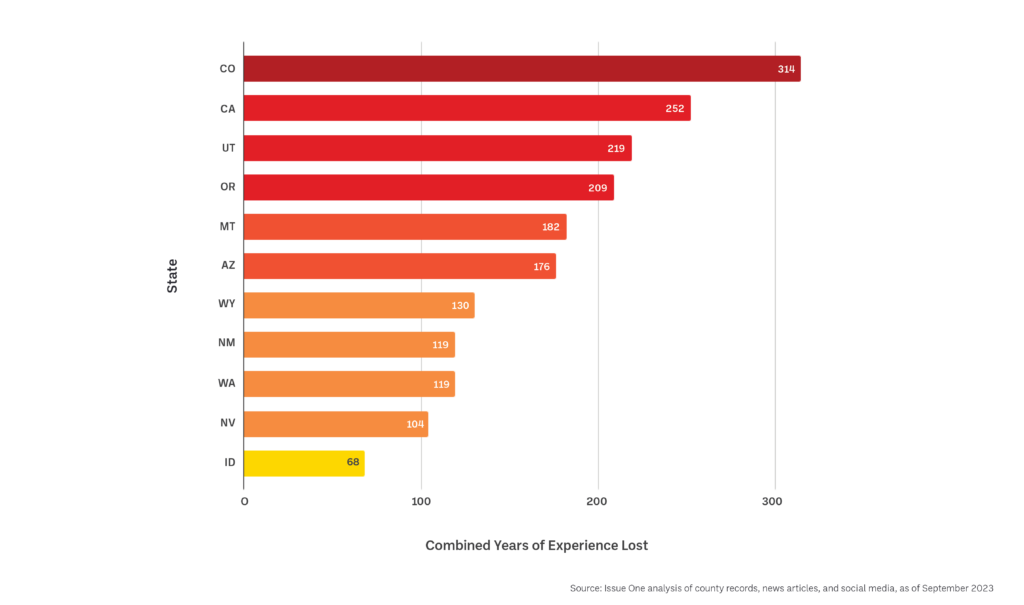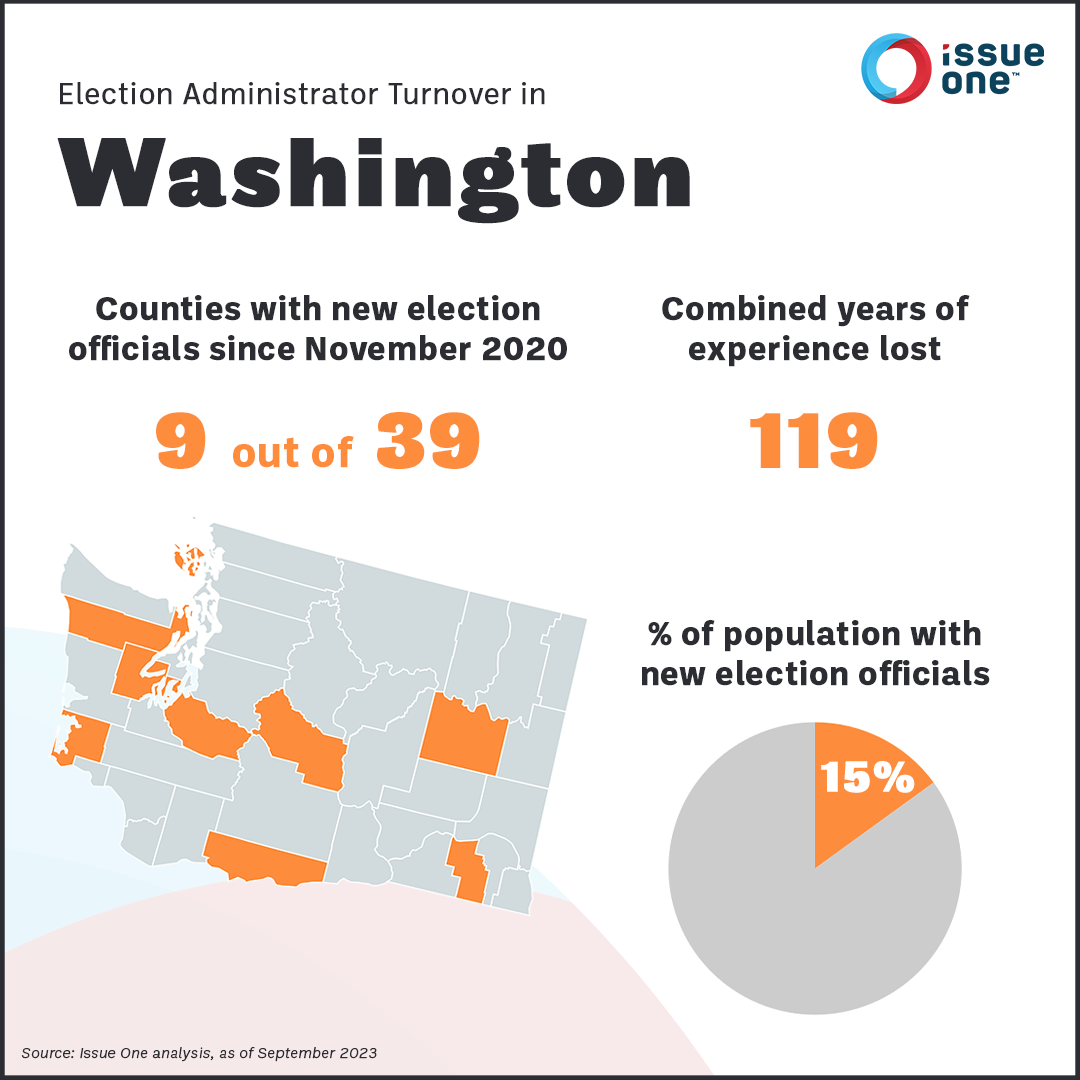Introduction
In the wake of a contentious presidential election in November 2020 that led to harassment and death threats against many once-obscure election administrators, droves of local election officials have opted to retire or leave their roles.
New research from Issue One shines a light on the scope of this exodus — including the high costs of this high turnover in terms of psychological duress, lost institutional knowledge, and the financial impacts of recruiting, hiring, and training new people to fill these critical positions.
Turnover is costly in many ways, and while election officials have a track record of rising to the occasion and performing heroically despite limited resources, Congress can help remedy this crisis by providing more funding and protections to these dedicated public servants.
For decades, local election officials served their communities in relative obscurity, working behind the scenes to administer free and fair elections. But the limelight was thrust upon them during the 2020 presidential election, partially because of a coordinated campaign of lies from then-President Donald Trump and his allies. This led to a deluge of harassment and threats. Because of this, many have decided to retire or leave their roles.
A survey last year by the Brennan Center found that 20% of local election officials were likely to quit before the 2024 presidential election. Issue One’s new research shows that the turnover rate among local election officials since 2020 is far higher, especially in battleground states where chief local election officials have been especially targeted by death threats and harassment.
What Issue One Found
Issue One’s new research shows that half of the 76 million Americans who live in the western United States have a new chief local election official since the 2020 presidential election. In this 11-state region — which includes two major presidential battleground states as well as a mix of Democratic-leaning and Republican-leaning states and where elections are typically administered at the county level by a single official — more than 160 chief local election officials have left their positions since November 2020.
This represents roughly 40% of the total chief local election officials in the region, which includes Arizona, California, Colorado, Idaho, Montana, Nevada, New Mexico, Oregon, Utah, Washington, and Wyoming, and where chief local election officials frequently hold titles such as county clerk, county recorder, county auditor, county registrar of voters, or county elections director. (In Arizona, election administration duties are typically split between two officials in each county — an elected county recorder and an appointed elections director. Issue One’s analysis includes both of these positions in Arizona’s figures. In the other 10 states, Issue One’s analysis focused on a single county-level official.)
The brain drain associated with this exodus is real. Issue One found that these officials took with them more than 1,800 years of combined experience.
Exodus of Election Officials

In a field as technical as election administration — where officials work with specialized voting machines, oversee ballot tabulation, and combat cybersecurity threats, among other responsibilities — it takes time for people to learn complex procedures, gain familiarity with equipment, and hone problem-solving skills for when challenges arise. Those with less experience are more prone to making small mistakes based on lack of knowledge — mistakes that, however innocuous, may be interpreted by hyper-partisans as malicious acts. To help prepare the next generation of election officials and election workers, jurisdictions across the country need to be investing significantly in training — on top of their routine investments in their voting equipment, the maintenance of their voter rolls, and other typical expenditures.
“These turnover rates signify a crisis in our democracy,” said Issue One Founder and CEO Nick Penniman. “The health and vibrancy of election administrators are essential to ensuring free and fair elections in our country. Congress should heed the call of America’s election officials and deliver regular funding and stronger protections for election workers, and law enforcement agencies should intensify their efforts to hold accountable those that threaten the dedicated officials who help Americans make their voices heard at the ballot box. Election after election, local officials rise to the occasion to administer free and fair elections that are safe and secure. Now is the time for policymakers and lawmakers to stand with them.”
New Faces Running Elections

A Troubling Exodus
In the 11-state western United States, roughly 40% of the chief local election officials are new since the 2020 presidential election — and in four states, Issue One found that number exceeds 50%.
In contrast, the annual turnover rate among people who hold state or local government jobs has typically been about 20% in recent years, according to the Bureau of Labor Statistics.
The turnover among chief local election officials has been particularly acute in presidential battleground states, such as Arizona (where Joe Biden won by 0.3%, or 10,457 votes) and Nevada (where Biden won by 2.4%, or 33,596 votes). But Republican-leaning states and Democratic-leaning states alike have not been immune from this trend.
In Arizona, Nevada, New Mexico, and Utah, the four states where the turnover rate has exceeded 50%, the turnover rates of chief local election officials were twice as high as the rates in Washington and Idaho, Issue One’s research shows.
And in the 161 counties in western states with new chief local election officials since November 2020, the typical number of years of experience held by these officials dropped from about 8 years to about 1 year.
At a Glance: Election Administrator Turnover Per State
1/11
Here are the specifics of what Issue One found in each state:
In Arizona, 80% of the state’s counties have at least one new chief local election official, and 98% of Arizonans will see the 2024 election administered by someone different than the officials who administered the 2020 election. Because election administration duties in Arizona are typically split between two officials in each county, this corresponds to 55% of the chief local election officials in Arizona’s counties being new since November 2020, and the officials who left these posts took with them a combined 176 years of experience. In the counties with new chief local election officials, the median amount of experience these officials had dropped from about 10 years to about 1 year. In four of the six most-populous counties in Arizona, both the elections director and county recorder are new since November 2020; in the other two counties, at least one of these officials is new.
In Nevada, 59% of the state’s counties have a new chief local election official, and 96% of Nevadans will see the 2024 election administered by someone different than the official who administered the 2020 election. The officials who left took with them a combined 104 years of experience. In the counties with new chief local election officials, the median amount of experience these officials had dropped from about 8 years to about 1 year.
In Utah, 59% of the state’s counties have a new chief local election official, and 85% of Utahns will see the 2024 election administered by someone different than the official who administered the 2020 election. The officials who left took with them a combined 219 years of experience. In the counties with new chief local election officials, the median amount of experience these officials had dropped from about 8 years to less than 1 year.
In New Mexico, 52% of the state’s counties have a new chief local election official, and 36% of New Mexicans will see the 2024 election administered by someone different than the official who administered the 2020 election. The officials who left took with them a combined 119 years of experience. In the counties with new chief local election officials, the median amount of experience these officials had dropped from about 8 years to about 3 years.
In California, 41% of the state’s counties have a new chief local election official, and 44% of Californians will see the 2024 election administered by someone different than the official who administered the 2020 election. The officials who left took with them a combined 252 years of experience. In the counties with new chief local election officials, the median amount of experience these officials had dropped from about 9 years to less than 1 year.
In Colorado, 38% of the state’s counties have a new chief local election official, and 48% of Coloradans will see the 2024 election administered by someone different than the official who administered the 2020 election. The officials who left took with them a combined 314 years of experience. In the counties with new chief local election officials, the median amount of experience these officials had dropped from about 8 years to less than 1 year.
In Montana, 34% of the state’s counties have a new chief local election official, and 23% of Montanans will see the 2024 election administered by someone different than the official who administered the 2020 election. The officials who left took with them a combined 182 years of experience. In the counties with new chief local election officials, the median amount of experience these officials had dropped from about 6 years to about 1 year.
In Oregon, 33% of the state’s counties have a new chief local election official, and 46% of Oregonians will see the 2024 election administered by someone different than the official who administered the 2020 election. The officials who left took with them a combined 209 years of experience. In the counties with new chief local election officials, the median amount of experience these officials had dropped from about 16 years to about 1 year.
In Wyoming, 30% of the state’s counties have a new chief local election official, and 22% of Wyomingites will see the 2024 election administered by someone different than the official who administered the 2020 election. The officials who left took with them a combined 130 years of experience. In the counties with new chief local election officials, the median amount of experience these officials had dropped from about 12 years to less than 1 year.
In Washington, 23% of the state’s counties have a new chief local election official, and 15% of Washingtonians will see the 2024 election administered by someone different than the official who administered the 2020 election. The officials who left took with them a combined 119 years of experience. In the counties with new chief local election officials, the median amount of experience these officials had dropped from about 12 years to less than 1 year.
And in Idaho, 23% of the state’s counties have a new chief local election official, and 41% of Idahoans will see the 2024 election administered by someone different than the official who administered the 2020 election. The officials who left took with them a combined 68 years of experience. In the counties with new chief local election officials, the median amount of experience these officials had dropped from about 7 years to less than 1 year.
These startling turnover rates have state’s top election officials concerned.
Arizona Secretary of State Adrian Fontes, for instance, has called the high turnover among election officials in Arizona a “plague.” This summer, he lamented to Hearst Television that “manufactured concocted problems” are “chasing experienced folks away.”
Fontes told Issue One that “the loss of these local officials means that the counties that run our elections will have to do more with less.”
He continued: “Increased federal funding would have an enormous impact as we work to recruit, train, and retain the next generation of election professionals. Additional federal investment will also address an unfunded mandate by which state and local governments assume the responsibility of holding elections for federal office without receiving the adequate amount of funding. Though the needs of Arizona and every other state are unique, it is in our common interest to ensure safe, secure, and accurate elections for every single American — no matter where they live.”
Similarly, Nevada Secretary of State Francisco V. Aguilar told Issue One: “Nevada has lost more than half of our top county election officials since the 2020 election, and many more staff within elections offices across the state. This has led to a critical loss of institutional knowledge and staffing shortages ahead of the 2024 presidential election. Elections don’t work without people and resources, and consistent federal funding for elections infrastructure would greatly strengthen our democracy.”
Institutional Knowledge Lost

Onslaught of Threats
Many of the personal stories of the local election officials who have resigned, retired, and left these positions since the 2020 presidential election are harrowing. Officials have had to deal with an onslaught of threats, harassment, conspiracy theories, and increased work loads.
Last year, Republican Leslie Hoffman resigned as the county recorder of Yavapai County, Arizona, after roughly a decade on the job. In an interview with The 19th, she said her decision to step down from her position came after two years of being heckled at public meetings and receiving threatening phone calls and hateful messages online — threats and harassment that led to the sheriff patrolling her house and her limiting her social events in her community.
“I asked one of the organizers of one of the groups, why are you going after us? We have no discretion in our jobs,” she said. “And he said, ‘Because you’re the easy mark.’ So I’m really disillusioned that people who deserve support don’t have it.”
Similarly, Republican Josh Daniels of Utah opted against running for reelection as the county clerk of Utah County in 2022 because of “the political dynamic,” he told Issue One earlier this year.
“We had internal battles in our county with our elected political officials that made our job difficult because those officials were giving credence to false and misleading election conspiracies and turning the administration of elections into a political issue that they could use in their own personal elections, reelections, and other political ambitions,” he continued.
“Unfortunately in the wake of the 2020 election, election administration has become a sort of political football,” he added. “I think you’re seeing election officials leave when they feel like the political officials that oversee their offices don’t support them and don’t have their backs.”
In Nevada, Republican Nikki Bryan worked as the clerk-recorder of Lyon County for more than 20 years, but decided last year to forego running for reelection again. “I love this county, and I want to see elections done right,” she told the Christian Science Monitor last year. “But I can’t fix the anger. I’ve tried.”
In California, Tommy Gong stepped down from his post as the clerk-recorder of San Luis Obispo County after six and a half years in mid-2021 amid a wave of election denialism. In 2021, he testified before Congress, recounting how a “mob mentality” had developed in San Luis Obispo County after the 2020 election. He said Republican Party activists demanded that he audit the election and the county’s voting machine. During one public meeting, one person asserted he might be a member of the Chinese Communist Party.
“We were all stunned,” he told the Senate Judiciary Committee. “After hearing about some of the threats of violence toward election officials across the nation as well as the increase in violent crimes toward Asians, that comment did prompt concerns for me and my family.”
After more than a decade on the job, Kammi Foote stepped down as the clerk, recorder, and registrar of voters of Inyo County, California, in April 2021. About her decision to leave, Foote told the Los Angeles Times that “it’s just a sense of being worn down and tired,” adding “in 2020, we found ourselves working seven days a week, months on end, under tremendous pressure.”
For her part, Aubrey Rowlatt, served just one term — four years — as the clerk-recorder in Carson City, Nevada. After that, the pressure wasn’t worth it. On top of her election administration duties, her responsibilities included addressing the estates, tax returns, and debts of those who died without official wills as well as digitizing historical documents. She said she had to put much of her other work on hold in the lead up to the 2020 election “because there’s no way I’m going on Fox News because I missed an election deadline.”
“You’re just working so many long hours, and then you’re being called idiots,” she told the Christian Science Monitor. “I had some man say he would sit outside my window and watch me.”
Similarly, in Washoe County, Nevada, Deanna Spikula resigned as the registrar of voters last year because of burnout born from threats. She endured unfounded personal attacks online, accusations of treason, and one death threat from someone who said, “Count the votes as if your life depends on it because it does.”
“Elections have always had their challenges, but the challenges now are far above and beyond even what was seen in 2020” she told the Reno Gazette Journal.
And in Montana, Nichol Scribner resigned earlier this year as the clerk and recorder, treasurer, and superintendent of schools of Sanders County, after serving for more than eight years.
After making her decision, she told the Sanders County Ledger: “I am sad to be leaving the good people of Sanders County, however, the last year has been extremely stressful as I have ongoing health issues and have endured multiple threats.”
Since the 2020 election, the Justice Department has charged people in Iowa, Massachusetts, Missouri, Nebraska, Nevada, Ohio, and Texas for threatening election officials. One man was sentenced to 18 months in prison. Several others are still awaiting trial. All the while, nine states have increased penalties for those convicted of making threats or harassing election officials and election workers.
Issue One has called for increased penalties against people who threaten those who help run our elections. Issue One has also called for an expansion of protections for election officials and election workers (including resources to protect themselves against doxxing) as well as an intensification of investigations and prosecutions by the Department of Justice.
Turnover is Expensive
Current and former election officials agree that high turnover rates cost voters — and taxpayers — in multiple ways.
High turnover can be expensive because it’s expensive to search for, hire, and train new staff. New election officials must be trained on the processes, procedures, and equipment that a jurisdiction uses.
This is true both in the states examined in this case study and the rest of the nation. Officials in multiple states across the country this year requested budgetary increases from state lawmakers specifically to cover additional training.
For instance, in South Carolina, the state election commission requested $3.2 million for training and technical support. And in Arizona, Secretary of State Adrian Fontes requested an additional $4.2 million from the state’s general fund, including $1.6 million for the state’s “critical election workforce,” which would allow Arizona to add employees for training and certifying election workers.
To make matters worse, if crucial positions remain vacant, current staff become demoralized and less productive. Moreover, when professionals with years of experience leave the field, voters in those areas lose vast amounts of institutional knowledge.
Combined Years of Election Administration Experience Lost in Western States Since November 2020

“Think of institutional knowledge as a savings account,” said Julie Wise, elections director of King County, Washington. “When a savings account has too little in it, emergencies become much more difficult to handle. Lost institutional knowledge increases the likelihood of human error. Even when an organization has well-documented procedures, new problems and questions arise. In those circumstances, being able to rely on experienced staff increases efficiency, effectiveness, and security.”
She continued: “Printing your ballot, sharing information about what’s on that ballot, answering voters’ questions, receiving and processing your ballot, ensuring security throughout the process, and sharing results all require trained, capable, experienced people working together efficiently, effectively, and transparently.”
Those sentiments were echoed by Josh Daniels, the former county clerk of Utah County, Utah.
“It’s important that people with professional experience and expertise are involved in the elections process as it becomes increasingly complex and onerous with a variety of important legal compliance mandates and deadlines and specific processes and equipment,” Daniels said. “When you get significant turnover, it can get really problematic as you lose institutional knowledge and institutional expertise.”
Conclusion
We are currently seeing a renewed push by civic organizations, veterans groups, corporations, and others to bolster a new generation of poll workers to help run elections. At the same time, it is essential for our democracy that lawmakers strengthen our election infrastructure and protect the dedicated people who keep it functioning.
Ensuring elections are accessible, secure, and accurate requires trained, dedicated, knowledgeable people. When local election officials leave these critical positions, the costs to institutional knowledge and running elections are real. Losing experienced people costs us in countless ways.
When elections workers feel undermined — by false information, lack of resources, or worse, threats of violence or death simply for doing their jobs — turnover rates can creep painfully high. Exhaustion, demoralization, and fear deplete the election administration field of the people whose knowledge and experience are necessary for the day-to-day administration of democracy.
In order to curb this exodus, lawmakers and policymakers in Washington, D.C., and across the country must step up to show election officials that they have their backs in the face of threats and harassment. They can do this by strengthening protections and fully funding our critical elections infrastructure to ensure that all voters can safely and securely make their voices heard in our elections.
You Might Be Interested In























